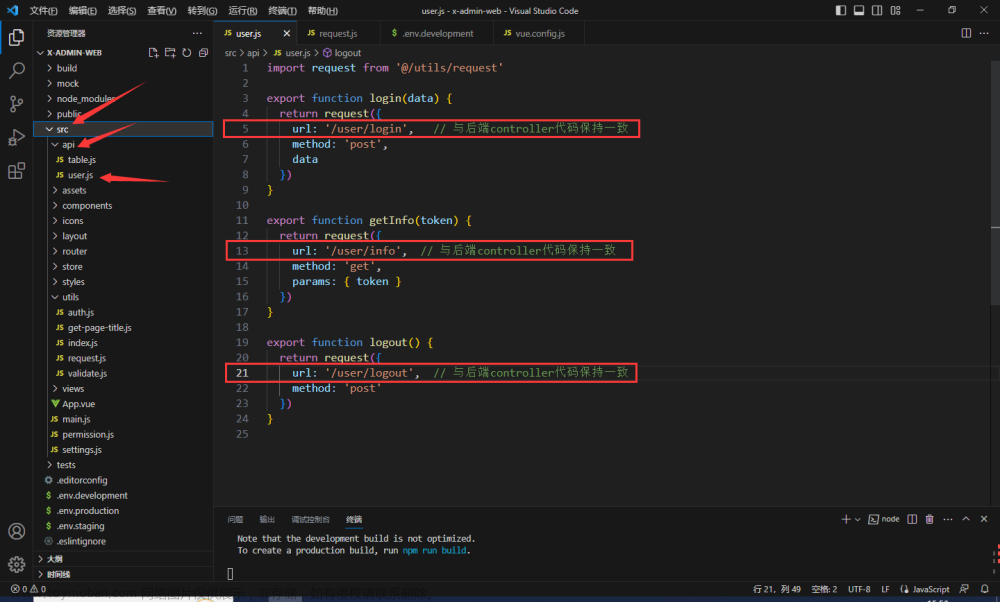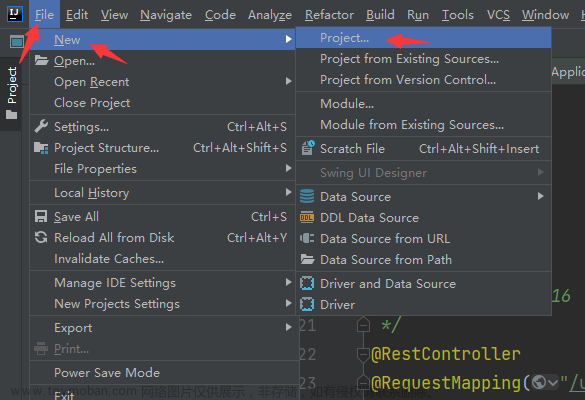SpringBoot的启动都需要如下的启动类
@SpringBootApplication
public class SpringBootDemoApplication {
public static void main(String[] args) {
SpringApplication.run(SpringBootDemo3Application.class, args);
}
}
分析启动类, 可以看出核心是:
- 注解@SpringBootApplication
- 方法SpringApplication.run(SpringBootDemoApplication.class, args)
其中@SpringBootApplication之前已经了解过,如果想要了解可以查看SpringBoot自动装配原理及分析
一、方法SpringApplication.run(SpringBootDemoApplication.class, args)
public static ConfigurableApplicationContext run(Class<?> primarySource, String... args) {
return run(new Class<?>[] { primarySource }, args);
}
//继续点进下一层run方法
public static ConfigurableApplicationContext run(Class<?>[] primarySources, String[] args) {
return new SpringApplication(primarySources).run(args);
}
-
首先new了一个SpringApplication对象
-
然后调用SpringApplication对象的run方法
二、实例化SpringApplication对象
调用SpringApplication的1个参数的构造函数,将启动类信息传入
public SpringApplication(Class<?>... primarySources) {
this(null, primarySources);
}

继续调用2个参数的构造方法,传入2个参数
public SpringApplication(ResourceLoader resourceLoader, Class<?>... primarySources) {
this.resourceLoader = resourceLoader;
//断言有主配置类, 否则抛出异常
Assert.notNull(primarySources, "PrimarySources must not be null");
//保存主配置类信息
this.primarySources = new LinkedHashSet<>(Arrays.asList(primarySources));
//根据加载的处理器确定web应用的类型
this.webApplicationType = WebApplicationType.deduceFromClasspath();
//获取所有的初始化器, 从spring.factories寻找
setInitializers((Collection) getSpringFactoriesInstances(ApplicationContextInitializer.class));
//获取所有的应用监听器, 从spring.factories寻找
setListeners((Collection) getSpringFactoriesInstances(ApplicationListener.class));
//推断main方法所在类
this.mainApplicationClass = deduceMainApplicationClass();
}
- 当前web应用类型

- 所有的初始化器

- 所有的应用监听器

- 在项目依赖所有的spring.factories文件中可以找到以上初始化器和监听器
#路径springframework\boot\spring-boot\2.3.4.RELEASE\spring-boot-2.3.4.RELEASE.jar!\META-INF\spring.factories
# PropertySource Loaders
org.springframework.boot.env.PropertySourceLoader=\
org.springframework.boot.env.PropertiesPropertySourceLoader,\
org.springframework.boot.env.YamlPropertySourceLoader
# Run Listeners
org.springframework.boot.SpringApplicationRunListener=\
org.springframework.boot.context.event.EventPublishingRunListener
# Error Reporters
org.springframework.boot.SpringBootExceptionReporter=\
org.springframework.boot.diagnostics.FailureAnalyzers
# Application Context Initializers
org.springframework.context.ApplicationContextInitializer=\
org.springframework.boot.context.ConfigurationWarningsApplicationContextInitializer,\
org.springframework.boot.context.ContextIdApplicationContextInitializer,\
org.springframework.boot.context.config.DelegatingApplicationContextInitializer,\
org.springframework.boot.rsocket.context.RSocketPortInfoApplicationContextInitializer,\
org.springframework.boot.web.context.ServerPortInfoApplicationContextInitializer
# Application Listeners
org.springframework.context.ApplicationListener=\
org.springframework.boot.ClearCachesApplicationListener,\
org.springframework.boot.builder.ParentContextCloserApplicationListener,\
org.springframework.boot.cloud.CloudFoundryVcapEnvironmentPostProcessor,\
org.springframework.boot.context.FileEncodingApplicationListener,\
org.springframework.boot.context.config.AnsiOutputApplicationListener,\
org.springframework.boot.context.config.ConfigFileApplicationListener,\
org.springframework.boot.context.config.DelegatingApplicationListener,\
org.springframework.boot.context.logging.ClasspathLoggingApplicationListener,\
org.springframework.boot.context.logging.LoggingApplicationListener,\
org.springframework.boot.liquibase.LiquibaseServiceLocatorApplicationListener
# Environment Post Processors
org.springframework.boot.env.EnvironmentPostProcessor=\
org.springframework.boot.cloud.CloudFoundryVcapEnvironmentPostProcessor,\
org.springframework.boot.env.SpringApplicationJsonEnvironmentPostProcessor,\
org.springframework.boot.env.SystemEnvironmentPropertySourceEnvironmentPostProcessor,\
org.springframework.boot.reactor.DebugAgentEnvironmentPostProcessor
# Failure Analyzers
org.springframework.boot.diagnostics.FailureAnalyzer=\
org.springframework.boot.context.properties.NotConstructorBoundInjectionFailureAnalyzer,\
org.springframework.boot.diagnostics.analyzer.BeanCurrentlyInCreationFailureAnalyzer,\
org.springframework.boot.diagnostics.analyzer.BeanDefinitionOverrideFailureAnalyzer,\
org.springframework.boot.diagnostics.analyzer.BeanNotOfRequiredTypeFailureAnalyzer,\
org.springframework.boot.diagnostics.analyzer.BindFailureAnalyzer,\
org.springframework.boot.diagnostics.analyzer.BindValidationFailureAnalyzer,\
org.springframework.boot.diagnostics.analyzer.UnboundConfigurationPropertyFailureAnalyzer,\
org.springframework.boot.diagnostics.analyzer.ConnectorStartFailureAnalyzer,\
org.springframework.boot.diagnostics.analyzer.NoSuchMethodFailureAnalyzer,\
org.springframework.boot.diagnostics.analyzer.NoUniqueBeanDefinitionFailureAnalyzer,\
org.springframework.boot.diagnostics.analyzer.PortInUseFailureAnalyzer,\
org.springframework.boot.diagnostics.analyzer.ValidationExceptionFailureAnalyzer,\
org.springframework.boot.diagnostics.analyzer.InvalidConfigurationPropertyNameFailureAnalyzer,\
org.springframework.boot.diagnostics.analyzer.InvalidConfigurationPropertyValueFailureAnalyzer
# FailureAnalysisReporters
org.springframework.boot.diagnostics.FailureAnalysisReporter=\
org.springframework.boot.diagnostics.LoggingFailureAnalysisReporter
源码解析
Springboot启动时,第一件重要事件就是构造SpringApplication对象,并主要完成如下事情。
- 设置源。实际就是设置Spring容器启动时依赖的初始配置类,也就是Springboot中的启动类;
- 设置WEB应用程序类型。例如可以是SERVLET,REACTIVE等;
- 加载并设置Bootstrapper,ApplicationContextInitializer和ApplicationListener;
- 设置应用程序主类的Class对象
然后调用run(),具体步骤如下:
三、调用SpringApplication对象的run方法
将main方法中的args参数传入, 分析源码
public ConfigurableApplicationContext run(String... args) {
// 秒表,用于记录启动时间;记录每个任务的时间,最后会输出每个任务的总费时
StopWatch stopWatch = new StopWatch();
//记录启动时间
stopWatch.start();
ConfigurableApplicationContext context = null;
Collection<SpringBootExceptionReporter> exceptionReporters = new ArrayList<>();
//让当前应用进入headless模式(自力更生模式)。java.awt.headless
configureHeadlessProperty();
//获取所有的运行监听器(这个监听器和普通的Spring监听器不同,它只用于Spring容器的启动过程中)
//默认会拿到一个EventPublishiingRunListener,它会在启动过程中的各个阶段发布对应的ApplicationEvent事件
SpringApplicationRunListeners listeners = getRunListeners(args);
//遍历 SpringApplicationRunListener 调用 starting 方法;相当于通知所有感兴趣系统正在启动过程的人,项目正在 starting
listeners.starting();
try {
//保存命令行参数(args),将启动参数args封装为ApplicationArguments对象
ApplicationArguments applicationArguments = new DefaultApplicationArguments(args);
//准备环境, 返回或者创建基础环境信息对象 : StandardServletEnvironment
ConfigurableEnvironment environment = prepareEnvironment(listeners, applicationArguments);
//根据环境配置需要忽略的bean信息
configureIgnoreBeanInfo(environment);
//打印banner
Banner printedBanner = printBanner(environment);
//创建IOC容器(createApplicationContext())
context = createApplicationContext();
exceptionReporters = getSpringFactoriesInstances(SpringBootExceptionReporter.class,
new Class[] { ConfigurableApplicationContext.class }, context);
//准备IOC容器的基本信息
prepareContext(context, environment, listeners, applicationArguments, printedBanner);
//刷新IOC容器。refreshContext ---> 创建容器中的所有组件(Spring注解)
refreshContext(context);
//容器刷新完成后 ---> 这是一个空方法,(目前无内容, 预留)
afterRefresh(context, applicationArguments);
//停止运行监听器停止运行, 记录容器启动完成花费的时间
stopWatch.stop();
if (this.logStartupInfo) {
new StartupInfoLogger(this.mainApplicationClass).logStarted(getApplicationLog(), stopWatch);
}
//所有监听器调用 listeners.started(context); 通知所有的监听器容器已创建完成
listeners.started(context);
//调用所有runners, 遍历执行runner的run方法
callRunners(context, applicationArguments);
}catch (Throwable ex) {
//IOC容器创建失败,监听器会发布一个创建失败的事件
handleRunFailure(context, ex, exceptionReporters, listeners);
throw new IllegalStateException(ex);
}
try {
//通知所有的监听器, 项目进入运行状态
listeners.running(context);
}catch (Throwable ex) {
handleRunFailure(context, ex, exceptionReporters, null);
throw new IllegalStateException(ex);
}
return context;
}
源码解析
1、StopWatch保存一些信息,应用名字,当前启动时间
2、创建引导上下文(context)
2.1:获取到所有之前创建的bootstrapers,挨个执行initialize方法,来完成对引导启动器上下文环境设置。(即引导启动的容器,在创建IOC容器前需要用到的公共对象就放在该容器中)
3、让当前应用进入headless模式。(用于在缺失显示屏、鼠标、键盘时候的系统配置)
4、获取所有RunListener运行时监听器(为了方便所有Listener进行事件感知,项目在启动)
4.1.getSpringFactoriesInstances去所有依赖的Spring.factories找SpringApplicationRunListener
4.2遍历所有SpringApplicationRunListener,调用starting方法,监听所有项目运行的状态(通知所有感兴趣系统正在启动过程的代码,项目正在starting)
4.3保存命令行参数;
4.4准备环境prepareEnviroment
4.4.1返回创建基础环境信息。StandardServletEnviroment
4.4.2配置环境信息对象(properties等)
4.4.2.1 读取所有配置元的配置属性
4.4.3绑定环境信息
4.4.4监听器调用environmentPrepared;通知所有监听器,当前环境准备完成。
4.5创建IoC容器(createApplicationContext)
4.5.1根据项目类型(Servlet)创建容器
4.5.2当前会创建AnnotationConfigServletWebServerApplicationContext;
4.6准备ApplicationContext IOC容器基本信息 prepareContext方法
4.6.1 保存环境信息
4.6.2 IOC容器的后置处理流程
4.6.3 应用初始化;applyInitializers
4.6.3.1 遍历所有的ApplicationContxtInitializer,调用initialize,来对IOC容器进行初始化扩展
4.7.4 遍历所有的Listener调用ContextPrepared。EventPublishListener;通知所有的监听器ContextPrepared
4.7.5 所有监听器 调用contextLoaded,通知上下文IOC容器加载完成。
4.7刷新IOC容器refresh(核心源码)
4.7.1创建容器中的所有组件
4.8刷新容器后的工作(空方法,扩展点,模板方法)
4.8.1所有监听器调用started方法,当前项目启动了
4.9调用runner方法;callRunners()
4.9.1获取容器中的ApplicationRunner
4.9.2获取容器中CommandLineRunner
4.9.3合并所有runner,并且按照@order进行排序
4.9.4遍历所有的runner调用run方法。
4.10如果有异常会调用Listener的failed方法
4.11调用所有监听器running方法Listener.running方法
4.12running方法如果有异常,还是调用Listener的failed方法。
四、总结
启动流程
-
从main方法开始。首先运行静态的run方法,创建一个springApplication对象,再运行run方法,工厂初始化配置在构造函数中完成。
构造函数中进行了初始化配置:通过类加载器,(loadFactories)读取classpath下所有的spring.factories配置文件,创建一些初始化配置对象;
run方法:通知监听器应用程序启动开始,创建环境对象environment,用于读取环境配置,如application.yml.
-
创建应用程序上下文-createApplicationContext,创建bean工厂对象
-
刷新上下文(启动核心)refreshContxt(工厂对象配置、bean处理器配置、类的扫描、解析、bean定义、bean类信息缓存、服务器Tomcat创建、bean实例化、动态代理对象创建)。
3.1 配置工厂对象,包括上下文类加载器,对象发布处理器,beanFactoryPostProcessor。
3.2 注册并实例化bean工厂发布处理器,并且调用这些处理器,对包扫描(主要是class)文件。
3.3 注册并实例化bean发布处理器beanPostProcessor。
3.4 初始化一些与上下文有特别关系的bean对象(创建tomcat服务器)
3.5 实例化所有bean工 程缓存的bean对象
3.6 发布通知上下文刷新完成(启动tomcat)
-
通知监听者-启动程序完成
启动中大部分对象都是beanFactory对象通过反射创建
相关知识点:
1.Spring监听器能帮助开发者监听web中特定的事件,比如比如 ServletContext, HttpSession, ServletRequest 的创建和销毁;变量的创建、销毁等等。
它采用了观察者模式,观察者模式的模型主要是由 观察者实体 和 主题实体 构成。
而Spring的监听器模式则结合了Spring本身的特征,也就是容器化。在Spring中,监听器
实体全部放在ApplicationContext中,事件也是通过ApplicationContext来进行发布,具体模型如下: 我们不难看到,虽说是通过ApplicationContext发布的事件,但其并不是自己进行事件的发布,而是引入了一个处理器—— EventMulticaster,直译就是事件多播器,它负责在大量的监听器中,针对每一个要广播的事件,找到事件对应的监听器,然后调用该监听器的响应方法,图中就是调用了监听器1、3、6。
我们不难看到,虽说是通过ApplicationContext发布的事件,但其并不是自己进行事件的发布,而是引入了一个处理器—— EventMulticaster,直译就是事件多播器,它负责在大量的监听器中,针对每一个要广播的事件,找到事件对应的监听器,然后调用该监听器的响应方法,图中就是调用了监听器1、3、6。
PS: 只有在某类事件第一次广播时,EventMulticaster才会去做遍历所有监听器的事,当它针对该类事件广播过一次后,就会把对应监听器保存起来了,最后会形成一个缓存Map,下一次就能直接找到这些监听器文章来源:https://www.toymoban.com/news/detail-824195.html
final Map<ListenerCacheKey, ListenerRetriever> retrieverCache = new ConcurrentHashMap<>(64);
Spring监听器中不仅采用了观察者模式,但其实它还用到了适配器模式,工厂模式等。
想要了解具体原理分析参考https://blog.csdn.net/u011709538/article/details/130833755文章来源地址https://www.toymoban.com/news/detail-824195.html
到了这里,关于SpringBoot启动流程的文章就介绍完了。如果您还想了解更多内容,请在右上角搜索TOY模板网以前的文章或继续浏览下面的相关文章,希望大家以后多多支持TOY模板网!







